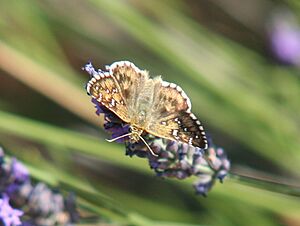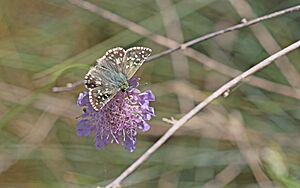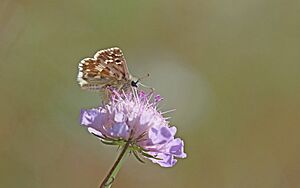Cinquefoil skipper facts for kids
Quick facts for kids Cinquefoil skipper |
|
|---|---|
 |
|
| Conservation status | |
| Scientific classification | |
| Genus: |
Pyrgus
|
| Species: |
cirsii
|
The Cinquefoil Skipper (Pyrgus cirsii) is a small, fast-flying butterfly. It belongs to a group of butterflies called "skippers" because of their quick, darting flight. This butterfly is found in parts of Europe and Asia.
Contents
About This Butterfly
The Cinquefoil Skipper has a wingspan (the distance from one wingtip to the other) of about 26–28 millimeters. This is roughly the size of a large coin. It can be quite tricky to tell apart from other similar skipper butterflies.
How to Spot It
This skipper is a medium size. It looks a lot like other butterflies in its genus (a group of closely related species) called Pyrgus. One butterfly it's often confused with is Pyrgus armoricanus.
A good way to identify the Cinquefoil Skipper is by a large, square white spot on the upper side of its front wing. It also usually has a second small spot near the base of the same wing. The underside of its back wing is often a reddish-brown color. This color helps it stand out from other Pyrgus species.
Sometimes, people think it's a type of subspecies (a group within a species) of the Carline Skipper (P. carlinae). This is because they can interbreed (have babies together) where their homes overlap. But the Cinquefoil Skipper usually has a square white spot, not a C-shaped one, on its front wing. Its underwings are also a deeper reddish-brown.
Where It Lives
The Cinquefoil Skipper is found across a wide area. You can see it from Spain all the way to Central Europe. There are also some groups of these butterflies in north-eastern Turkey and in Armenia.
Its Home (Habitat)
The Cinquefoil Skipper likes to live in sunny, dry grasslands. These places often have patches of bare ground and are stony. The soil is usually shallow and rich in certain minerals.
These areas are often grazed regularly by animals like sheep. They also have many patches of a plant called Potentilla verna agg., which is a type of cinquefoil. In the past, they also lived in very thin pine forests. The size of these habitats is important. The butterfly needs large, connected areas of grassland to thrive.
Life and Habits (Ecology)
The Cinquefoil Skipper usually has one generation of butterflies each year. They appear relatively late in the year, from late July to mid-September. Most of them fly in the second half of August. The last ones, often females, can be seen in mid-September.
Where They Fly
In Bavaria, Germany, these butterflies have been found at different heights. They can be as low as 160 meters (about 525 feet) above sea level. They can also be as high as 500 meters (about 1,640 feet). Most of them are found between 280 and 400 meters (about 920 to 1,310 feet).
What They Eat
Adult Cinquefoil Skippers, both males and females, visit many different kinds of flowers to drink nectar. They are not picky about the color of the flowers. Males also like to drink from moist soil. If the habitat is good, you can find many Cinquefoil Skippers flying around.
Caterpillar Life
The caterpillars of the Cinquefoil Skipper mostly eat cinquefoil plants (Potentilla species). In Central Europe, their favorite food is the spring cinquefoil (Potentilla verna agg.). Other cinquefoil plants they eat include Potentilla cinerea, Potentilla incana, Potentilla hirta, and Potentilla pusilla.
After the female butterfly lays eggs in August and September, the caterpillar hatches and spends the winter. The first new caterpillars are seen in March. These caterpillars live inside "leaf bags" that they make. This makes them easier to find if you know what to look for. It takes a long time, over three months, for a caterpillar to grow into an adult butterfly.
How They Behave
Both male and female Cinquefoil Skippers look for areas with little vegetation. Males will claim a small area and defend it from other males. They will check almost every butterfly that flies by.
Females that are ready to lay eggs fly very low. They land on sparse plants in bare soil to find places for their eggs. They can't tell if a plant is suitable from the air. So, they land on different plants and check them by touching the leaves with their antennae. If it's not a cinquefoil, they keep looking. If they find a cinquefoil, they tap the leaves with their antennae. If a leaf feels right, they usually lay their eggs on the underside of the leaf. Sometimes, they lay them on the stem of the plant.
Protecting This Butterfly
The Cinquefoil Skipper is considered vulnerable, meaning it's at risk. Like many Pyrgus species, it needs a fairly large habitat. It lives in dry, sunny grasslands on limestone. The caterpillars only live in the driest, least fertile spots.
These special places are disappearing for several reasons:
- Eutrophication: This means the soil gets too many nutrients, often from pollution in the air. This makes plants grow too thick.
- Less grazing: When fewer sheep or other animals graze, the grass grows too tall and dense.
- Habitat loss: Many grasslands are being lost to development or other land uses.
- Climate change: Changes in weather patterns can also harm their habitats.
When the plants grow too thick and tall, the caterpillars can't develop well, and the females won't lay eggs there. This makes it harder for the butterfly populations to grow.
To help the Cinquefoil Skipper, special efforts have been made in the Steigerwald region since 1998. These efforts include:
- Clearing bushes and thinning out grasslands to make their homes larger.
- Bringing grazing animals back to these areas. The current habitats are now grazed by sheep and goats at least twice a year, often more. This helps keep the vegetation short and open, just how the butterflies like it.
Classification
Some scientists believe that P. carlinae and P. cirsii are not completely separate species. They think they might just be different types (subspecies) of the same butterfly.




